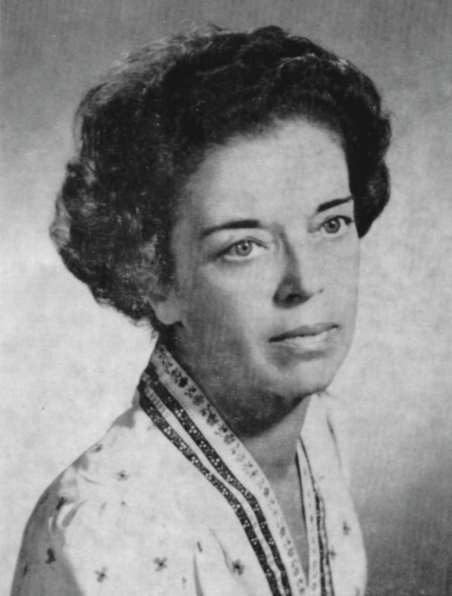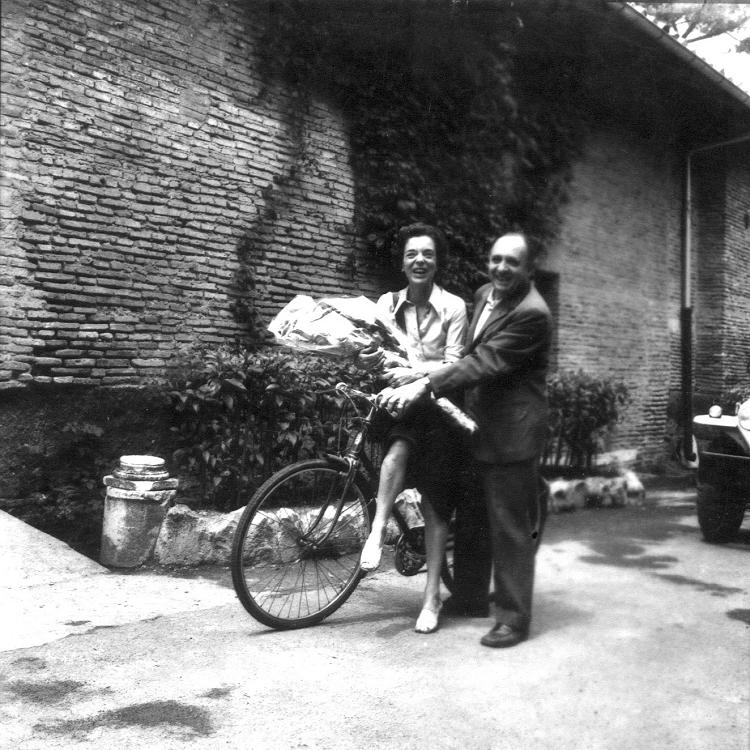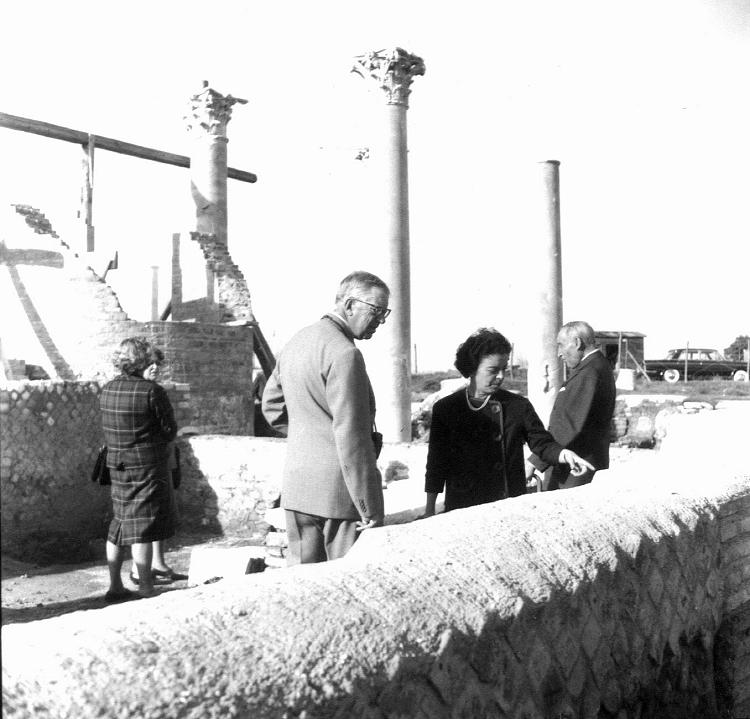MARIA FLORIANI SQUARCIAPINO (1917-2003)
English translation of: Paola Olivanti, "Maria Floriani Squarciapino", Dizionario biografico dei Soprintendenti Archeologi (1904-1974), Papadopoulos J. (ed.), Bologna 2012, 726-728.

Born in Rome on 30 January 1917, she graduated from La Sapienza University with Pietro Romanelli with a thesis on the School of Aphrodisias (1939). After obtaining the specialization diploma in classical archeology at the same university with a work on the decorative panels of the temple of Venus Genetrix in the Forum of Caesar, she collaborated as a volunteer assistant at the chair of Archeology and History of Classical Art (1939-1947). At the same time she began her collaboration with state and municipal institutions, also participating in the preparation of the Augustan Exhibition of Romanity (1936) and taking care of the arrangement of the numismatic gipsoteca of the Museum of Roman Civilization (1942-1946).
In 1951, as a fellow, she spent six months at the Archaeological School of Athens, participating in the excavations of Phaistos and Gortyn.
In 1946 she began her career in the Administration of Antiquities and Fine Arts at the Superintendency for Antiquities of Rome III, Excavations of Ostia Antica; she goes through the various grades until she holds the position of Superintendent in the same Institute (1963-1974). Her career as an official and then as a manager took place entirely at the Superintendency of Ostia (28 years overall), with the exception of a short period of command at the Superintendency of Rome IV (Forum and Palatine Hill), called by Pietro Romanelli to direct the excavation of the Comitium (1955-1957).
Initially, the scholar served as a salaried worker with the duties of Inspector (until 1949), then as Assistant Inspector (from 1950) and following promotion for joint seniority as Group A Inspector, grade IX (from 1952). In 1958 she was appointed Director of Class II for comparative merit, then Superintendent of Class II in 1968.
From the academic year 1967-68 she was assigned the task of teaching Archeology of the Roman provinces at the Faculty of Letters of the University of Rome, an assignment renewed for the academic year 1973-74.
In June 1974 she resigned as an official in the Ministry of Education, Directorate General for Antiquities and Fine Arts, to take up the position of professor of Archeology of the Roman provinces at the University of Rome "La Sapienza". Having become ordinary since 1976, she held the position until retirement in 1987. At the time of termination of service in the Superintendency (1974) she was conferred the position of Senior Manager.
Squarciapino has always maintained a privileged relationship with Ostia, which she experienced as a site to be protected and which offered many job opportunities, but also a privileged theme for her research activity. As Superintendent, she gave a decisive impulse to the development of the site and to a deeper knowledge of it, promoting scientific and cultural initiatives and dedicating daily attention to the organizational and operational aspects. Under her direction, the restoration project started by Pietrogrande continued, limiting the excavation to soundings in individual buildings, on the occasion of the detachment and restoration of mosaics, wall paintings or other works on the walls. In addition, the photographic campaign of the material preserved in the Ostian Antiquarium was completed, with CNR funds, to complete the cataloging of the materials preserved in it.

Maria Floriani Squarciapino, in front of the Office of the Superintendent of Ostia,
with her bicycle and the guard Mr. G. Conca. 1970's.
At the same time she oversaw the arrangement of the Museum of the via Ostiense in Porta S. Paolo, the Museum of the Castle of Julius II in Ostia Antica and the Ostian Museum within the excavations of Ostia.
As can be deduced from the bibliography, a large part of her scientific activity has been dedicated to Ostian themes, themes sometimes just mentioned and then taken up again by colleagues, often reaching results of great importance. As a demonstration of the commitment made in her Ostian years, it is enough to remember the publication of the necropoles (Excavations of Ostia, III. The necropoles 1. The tombs of the Republican and Augustan age, Rome 1958, in collaboration with I. Gismondi, G. Barbieri, H. Bloch and R. Calza) and the study on the eastern cults of the city (The Eastern Cults in Ostia, EPRO 3, Leiden 1962); to these must be added the numerous contributions on specific problems (the so-called sculptured bricks, the clay matrices, the engraved glass, the mosaics of the baths of Porta Marina), to arrive at the discovery of a sanctuary of the Bona Dea in the fifth Ostian region (A new sanctuary of the Bona Dea in Ostia, "Accounts of the Pontifical Academy of Archeology", n.32, 1959-60, pp. 93-95) and the study of the Synagogue, started with the publication of an introductory report (The Synagogue recently discovered in Ostia, "Accounts of the Pontifical Academy of Archeology", n.34, 1961-62, pp. 119-132; The Synagogue of Ostia, "Art Bulletin", n.46, 1961, pp. 326-337), which will afterwards lead to a series of observations on the possible classifications of this type of monument summarized in the Synagogue entry of the Encyclopedia of Eastern Classical Ancient Art.

Maria Floriani Squarciapino illustrates to King Gustaf Adolf of Sweden
the excavation of the Ancient Synagogue of Ostia. 1960's.
Her scientific interests were not limited to Ostia, but also concerned Aphrodisias and the "School" of Aphrodisias, already the subject of her degree thesis, and then Leptis Magna and Roman Africa. The interest in these issues has also been achieved in the didactic field, in the context of the teaching of Archeology of the Roman provinces.
Among the rich scientific production we must remember some works that are real cornerstones of research; the studies on the school of Aphrodisias (The school of Aphrodisias, "Studies and materials of the Museum of the Roman Empire", n. 3, 1943; The school of Aphrodisias, 40 years later, "Classical archeology", n. 35, 1983, pp. 74-87) highlight her critical penetration skills; they are matched by the more recent work on the sculpture of the Severan Forum of Leptis Magna (Sculptures of the Severan Forum of Leptis Magna, Monographs of Libyan archeology, n.10, Rome 1974; Floriani Squarciapino 2003), the result of participation in the Italian archaeological mission to Leptis Magna directed by Renato Bartoccini (1952-1963).
Other perhaps more occasional but equally fruitful lines of research were the one on the Lusitanian city of Merida (the ancient Augusta Emerita, wokring hypothesis on the group of sculptures from Pan Caliente, "Augusta Emerita", Madrid 1976, pp. 55-62) and the one linked to the Italian mission in Syria at the site of ancient Ebla (1964-1966), a mission then directed with important results by Paolo Matthiae (The archaeological mission in Syria of the University of Rome. The Tell Mardikh campaigns of 1964 and 1965, "Accounts of the Pontifical Academy of Archeology", n.38, 1965-66, pp. 143-156).
In addition to the institutional activity, the commitment of the scholar to participation in scientific initiatives and associations should be remembered: the International Association of Classical Archeology (AIAC), of which she was secretary general (1974-1994) and Vice President (1994-1997) and related editing of the "Archaeological Fasti" (of which she has been assistant since 1950, to then take on the co-direction and finally the direction since 1975), the Institute of Roman Studies, the Pontifical Roman Academy of Archeology.
Squarciapino died in Rome on 29 September 2003. As functioning archaeologist and then as a teacher at the University she has always been concerned with making the results of her work and studies available to the scientific community and the public, aware of the fallout that a correct disclosure of discoveries and finds can have on the protection of heritage.
Photo credits:
- AIACNews 39-40, 2004, 4.
- With the bike: Parco Archeologico di Ostia.
- With King Gustav: Parco Archeologico di Ostia.